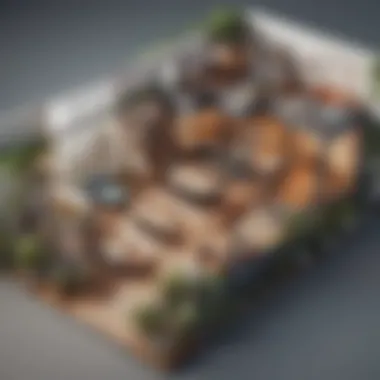Unlocking Unique Living: A Comprehensive Guide to Alternative Housing Options


Exploring Alternative Housing Options:
Introduction to Non-Conventional Living Spaces
In today's ever-evolving real estate landscape, the concept of housing has transcended the traditional confines of apartments. It has given rise to a myriad of innovative living arrangements that cater to diverse lifestyle preferences. This comprehensive guide embarks on a journey through unconventional housing options, offering valuable insights for individuals keen on exploring a different approach to residential living.
Embracing Co-Living Spaces and Community Living
One intriguing alternative to apartments is the concept of co-living spaces, where individuals reside in shared accommodations that foster a sense of community and collaboration. These spaces provide residents with the opportunity to engage in communal activities, share resources, and cultivate meaningful relationships with like-minded individuals. By delving into the intricacies of co-living environments, this guide sheds light on the transformative potential of communal living beyond conventional apartment setups.
Tiny Homes: A Compact Yet Sustainable Living Solution
Amidst the housing landscape, tiny homes have emerged as a compact and sustainable housing option that challenges the notion of excessive living space. These miniature dwellings prioritize functionality and minimalism, offering inhabitants a cozy and eco-friendly living experience. By exploring the nuances of tiny home living, this guide illuminates the possibilities of embracing a simpler yet fulfilling lifestyle in lieu of traditional apartment living.
Navigating Houseboats and Mobile Dwellings
For those seeking a truly unique housing alternative, houseboats and mobile dwellings present an unconventional yet captivating option. These floating abodes and movable residences blur the boundaries between land and water, inviting residents to experience a dynamic living environment unlike any other. By venturing into the realm of houseboats and mobile dwellings, this guide ventures into uncharted territories of residential living, showcasing the allure of embracing a life less ordinary.
Synthesizing the Exploration of Non-Conventional Living Arrangements
As we traverse through the realm of alternative housing options, it becomes evident that the traditional apartment is no longer the sole epitome of residential living. Co-living spaces, tiny homes, houseboats, and mobile dwellings offer individuals a diverse array of living choices, each encapsulating a unique lifestyle ethos. By delving into these unconventional habitats, this guide equips readers with a comprehensive understanding of the possibilities that lie beyond the conventional confines of apartment living.
Introduction
In this comprehensive guide, we delve into the realm of alternatives to traditional apartments. The ever-evolving landscape of housing trends prompts individuals to seek innovative living arrangements that cater to a diverse range of lifestyles and preferences.
Understanding the Shift in Housing Trends
Rise of Alternative Housing Options


The rise of alternative housing options signifies a paradigm shift in how individuals perceive and select their living spaces. These non-conventional options offer a departure from the conventional apartment living, providing unique benefits and experiences that resonate with the contemporary individual seeking a distinct way of life. Embracing alternative housing options reflects a growing inclination towards customized and community-oriented living environments, fostering a sense of belonging and purpose.
Factors Driving the Search for Alternatives
Various factors contribute to the increasing quest for alternative housing options. Economic considerations, changing societal norms, and a desire for sustainable living play pivotal roles in steering individuals towards exploring unconventional residential choices. The allure of experiencing different forms of communal living and engaging with diverse communities propels individuals to seek alternatives beyond traditional apartments.
Purpose of the Article
Highlighting Diverse Housing Alternatives
This article aims to shed light on a myriad of diverse housing alternatives available beyond the confines of traditional apartments. By showcasing a range of unconventional living spaces such as co-living arrangements, tiny homes, converted spaces, and houseboats, readers can gain insights into the unique characteristics and advantages of each option. Highlighting diverse housing alternatives provides readers with a broader perspective on the possibilities that exist in the realm of non-conventional living.
Providing Insights for Decision-Making
Through providing insights for decision-making, this article equips readers with valuable information to navigate the array of housing alternatives available to them. By examining the pros and cons of each housing option, readers can make informed decisions based on their needs, preferences, and lifestyle choices. Empowering individuals with the knowledge needed to choose a living space that aligns with their values and aspirations is a fundamental goal of this article.
Co-Living Spaces
People nowadays are looking for unconventional housing options, and co-living spaces have garnered significant attention in this context. Co-living spaces represent a modern approach to shared living arrangements, where residents have their private rooms but share common areas. The appeal of co-living lies in its ability to foster a sense of community and collaboration among like-minded individuals. By emphasizing social interaction and shared experiences, co-living spaces cater to a growing need for connection in an increasingly isolated world. This section will delve into the various aspects that make co-living spaces a compelling alternative to traditional apartments.
Overview of Co-Living
Definition and Concept
Co-living, at its core, revolves around the concept of shared living spaces that encourage collaboration and community engagement. This innovative housing model promotes affordability and a sense of belonging, providing individuals with more than just a place to live. The defining feature of co-living is its focus on creating a supportive environment where residents can interact, socialize, and build meaningful relationships. This section will explore the benefits and drawbacks of this unique concept and its relevance in the context of alternative housing choices.
Benefits of Co-Living Arrangements
Co-living arrangements offer a multitude of benefits that set them apart from traditional housing options. One of the key advantages is the opportunity for residents to engage in shared experiences and activities, fostering a strong sense of community. Additionally, co-living spaces often come equipped with various amenities and services that enhance the overall living experience. From shared kitchens and workspaces to organized social events, these communities provide a holistic approach to modern living. However, challenges such as privacy concerns and differing lifestyles also accompany this living arrangement, shaping a dynamic landscape of pros and cons for potential residents.
Popular Co-Living Communities


Shared Amenities and Services
One of the hallmarks of popular co-living communities is the diverse range of amenities and services they offer to residents. These spaces go beyond providing basic living necessities and often include additional perks such as fitness centers, co-working spaces, and communal dining areas. By incorporating these shared facilities, co-living communities aim to create a convenient and upscale living environment that caters to the needs and preferences of their residents. This sub-section will explore the significance of shared amenities in shaping the appeal and functionality of co-living spaces.
Community Engagement
Community engagement is a vital aspect of co-living environments, fostering connections and interactions among residents. Through organized events, workshops, and social gatherings, co-living communities encourage meaningful engagement and collaboration, nurturing a sense of belonging and camaraderie. Residents have the opportunity to participate in community-driven activities and initiatives, creating a cohesive and supportive living ecosystem. However, balancing individual autonomy with communal responsibilities poses a continuous challenge in maintaining community harmony and effectively managing shared spaces.
Tiny Homes
Tiny Homes play a crucial role in this comprehensive guide on exploring alternatives to traditional apartments. These compact dwellings have gained popularity due to their unique benefits and considerations that cater to individuals seeking a minimalist and sustainable lifestyle. Tiny Homes, characterized by their small footprint and efficiently designed spaces, offer a refreshing departure from conventional large-scale living arrangements. Benefits of Tiny Homes: ** Sustainability and Minimalism:** Sustainability and Minimalism are key features of Tiny Homes, emphasizing eco-friendly practices and a clutter-free living environment. By utilizing sustainable materials and focusing on minimalistic design principles, Tiny Homes contribute to reducing environmental impact and fostering a simpler yet fulfilling lifestyle. The strategic integration of sustainable technologies in Tiny Homes underscores their appeal to environmentally conscious individuals who prioritize energy efficiency and eco-friendliness. ** Flexibility in Design and Mobility:** The flexibility in design and mobility of Tiny Homes allows for customized solutions tailored to individual needs and preferences. Whether it's optimizing space utilization or incorporating innovative storage solutions, Tiny Homes enable residents to adapt their living spaces according to changing requirements. Additionally, the mobility aspect of Tiny Homes offers the freedom to relocate easily, making it an attractive option for those seeking a dynamic and versatile housing solution. Challenges of Tiny Home Living: ** Space Constraints and Storage Solutions:** While tiny homes promote efficient use of space, residents may encounter challenges related to limited living area and storage options. Managing possessions and ensuring adequate storage solutions require creative organizational strategies to maximize space utilization effectively. Despite the constraints, innovative storage solutions such as multi-functional furniture and clever spatial arrangements can help address these challenges. ** Regulatory Hurdles and Zoning Laws:** Negotiating regulatory hurdles and zoning laws represents a significant challenge for individuals opting for Tiny Home living. With varying regulations governing the construction and placement of Tiny Homes in different jurisdictions, navigating legal requirements and compliance standards can be complex. Overcoming regulatory obstacles demands thorough research and adherence to zoning laws to ensure a seamless integration of Tiny Homes into existing housing landscapes.
Converted Spaces
In this section, the article delves into the realm of converted spaces, presenting a compelling discussion on the importance and relevance of this topic within the broader context of exploring alternatives to traditional apartments. Converted spaces offer a unique perspective on living arrangements, repurposing existing structures to cater to diverse housing needs. These spaces provide individuals with an opportunity to step away from conventional living and embrace innovative, adaptive environments that promote creativity and resourcefulness. By focusing on the transformation of underutilized buildings, the section sheds light on the practicality and sustainability of repurposing spaces to meet the evolving demands of modern living.
Repurposing Unused Buildings
Loft Conversions
When it comes to loft conversions, the article highlights the significance of this specific aspect within the converted spaces discussion. Loft conversions involve the transformation of underused attic or loft areas into functional living spaces, adding a layer of versatility and charm to existing structures. This architectural maneuver not only maximizes space utilization but also infuses a sense of character and uniqueness into the living environment. The advantages of loft conversions lie in their ability to optimize vertical space, creating airy and open living areas that are conducive to modern living standards. While challenges may exist in terms of structural considerations and design complexities, loft conversions remain a popular choice for individuals seeking a blend of heritage and modernity in their living spaces.
Warehouse Transformations
Warehouse transformations play a pivotal role in the exploration of converted spaces, bringing forth the essence of adaptability and innovation in repurposing large industrial spaces into residential units. The key characteristic of warehouse transformations lies in their ability to preserve the industrial aesthetics of the original structure while seamlessly integrating residential functionalities. This unique fusion of past industrial glory with present-day living requirements makes warehouse transformations a sought-after choice in the realm of alternative housing options. The section delves into the advantages and disadvantages of warehouse transformations, emphasizing their spacious interiors, industrial-chic allure, but also addressing potential challenges related to zoning laws and structural modifications, providing readers with a comprehensive overview of this intriguing housing alternative.
Unique Living Environments
In examining unique living environments, the article delves into the realm of artistic spaces and historical buildings renovations, shedding light on their significance within the narrative of exploring alternatives to traditional apartments. Artistic spaces offer individuals a canvas to express their personalities through unconventional living arrangements, emphasizing the fusion of art and living functionalities. The key characteristic of artistic spaces lies in their ability to inspire creativity and imagination, fostering a living environment that transcends conventional norms and encourages self-expression. While advantages include unmatched aesthetic appeal and a sense of cultural immersion, challenges may arise concerning maintenance and practicality, adding depth to the conversation on artistic living spaces.
Historical buildings renovations represent a homage to the past, revitalizing architectural masterpieces to suit contemporary living standards. The distinctive feature of historical buildings renovations lies in their ability to preserve heritage while integrating modern conveniences seamlessly. This marriage of historical charm and modern comfort makes historical buildings renovations a compelling choice for those seeking a blend of tradition and innovation in their living spaces. By exploring the advantages and disadvantages of historical buildings renovations, the article equips readers with a nuanced understanding of this unique housing alternative, highlighting the essence of preserving history while embracing the future.


Houseboat Living
Houseboat Living is a unique dwelling concept explored within the article's comprehensive guide to alternative housing options. The allure of living on water captivates many seeking a distinctive lifestyle. Houseboats offer an unconventional yet harmonious blend of nature and modern living.
Exploring Life on Water
Benefits of Houseboat Living
Houseboat Living presents a myriad of benefits that cater to individuals seeking serenity and a deep connection with nature. The tranquility of waterfront living, the gentle rocking of the boat, and the constant proximity to nature are primary appeals of this lifestyle. Additionally, the flexibility to change locations easily and the reduced environmental footprint contribute to the attractiveness of Houseboat Living.
Navigating Challenges of Water-Based Living
While Houseboat Living has its allure, challenges such as limited living space, potential maintenance issues, and the need to adhere to specific regulations can pose hurdles. Adapting to the nuances of living on water requires a shift in mindset and a readiness to embrace a more minimalist lifestyle.
Community Dynamics
Waterfront Communities
Waterfront Communities epitomize a unique social environment where residents bond over their shared affinity for water-based living. The camaraderie fostered in these communities enhances the overall living experience, creating a strong sense of belonging and shared purpose. The picturesque views and communal amenities further enrich the quality of life in Waterfront Communities.
Shared Resources and Responsibilities
In Waterfront Communities, shared resources and responsibilities play a crucial role in promoting cooperation and sustainability. Collective efforts towards maintaining the community, waterfront conservation, and organizing social events foster a strong sense of community spirit. However, coordinating shared responsibilities and decision-making processes may also give rise to occasional challenges that contribute to the dynamic nature of these living environments.
Conclusion
In this comprehensive guide to exploring alternatives to apartments, the conclusion serves as the pivotal section encapsulating the essence of divergent housing options. As the housing landscape evolves, individuals are increasingly seeking unconventional living arrangements that align with their unique lifestyles and preferences. The significance of the conclusion lies in providing a holistic overview of the diverse alternatives discussed throughout the article, emphasizing the importance of embracing novelty and innovation. By delving into co-living spaces, tiny homes, converted spaces, and houseboat living, this guide showcases the myriad possibilities available beyond the traditional confines of apartments. Through an in-depth analysis of the advantages, challenges, and financial considerations associated with each alternative, the conclusion reiterates the imperative of personalized living experiences that cater to individual needs and aspirations. By embracing diversity in housing choices, individuals can forge a path towards more fulfilling and enriching living environments that resonate with their values and desires. The synthesis offered in the conclusion underscores the need for adaptable and forward-thinking approaches to housing, paving the way for a future where creativity and originality reign supreme.
Embracing Diversity in Housing Choices
Personalized Living Experiences
Personalized living experiences represent a cornerstone in the realm of alternative housing, offering a bespoke approach to accommodation that transcends the cookie-cutter designs of conventional apartments. The allure of personalized living experiences lies in the ability to tailor living spaces to individual preferences, fostering a sense of ownership and identity unique to each inhabitant. By allowing residents to participate in the design process, these housing options cultivate a deep sense of connection and belonging, enriching the overall living experience. The key characteristic of personalized living experiences is their flexibility and adaptability, enabling residents to customize their space according to their changing needs and lifestyle requirements. This level of personalization not only enhances comfort and satisfaction but also nurtures a sense of creativity and self-expression among dwellers. While the advantages of personalized living experiences include greater autonomy and design control, potential disadvantages may revolve around higher costs associated with customization and maintenance. Nonetheless, in the context of this article, personalized living experiences emerge as a beneficial choice for individuals seeking to break away from traditional norms and embrace living arrangements that reflect their individuality and character.
Future Trends in Alternative Housing
The discussion on future trends in alternative housing spotlights the evolving landscape of residential options, hinting at upcoming innovations that promise to revolutionize the way we perceive and interact with our living spaces. As urbanization intensifies and sustainability takes center stage, alternative housing solutions are poised to play a pivotal role in shaping the future of habitation. One key characteristic of future trends in alternative housing is their emphasis on eco-friendliness and resource efficiency, aligning with the growing global consciousness towards environmental preservation and green living. By integrating technologies such as renewable energy, smart home systems, and recycled materials, future housing solutions offer a sustainable and forward-thinking approach to urban living. This emphasis on sustainability not only benefits the environment but also contributes to cost savings and energy efficiency for residents. While the unique feature of future trends in alternative housing lies in their ability to blend modern amenities with eco-conscious designs, potential disadvantages may stem from the initial investments required for implementing these cutting-edge technologies. Nevertheless, in the context of this article, future trends in alternative housing emerge as a popular choice for forward-looking individuals and communities seeking homes that marry innovation with sustainability, ushering in a new era of responsible and progressive living.







